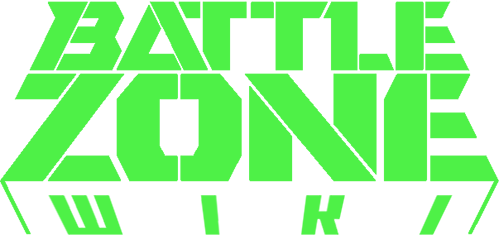| Information |
|---|
| Date: 1999 |
| Source: pandemicstudios.com |
Transcript[]
Part One[]
With research and development moving along at full speed, both the Soviets and Americans hit a brick wall in their mutual lack of bio-metal. The supposed "vunder-substance" that Arkin ranted endlessly about was in extremely short supply on Earth. Neither side had enough to complete more than a few vehicles.
Fortunately for both nations, the Blitzkrieg mentioned in Kranken's memo took far longer than he'd intended. By early July of 1947, when the moon Nazis finally packed into large carrier ships for the invasion of Earth, they were tired, hungry, and desperate.
It didn't help morale at all when half of the German invasion force was obliterated upon descent to Earth by American rockets. And the ones who did reach the Arctic region had little time to prepare for battle, as they were greeted unceremoniously by the U.S.'s small but well-positioned new army. After an intense land battle that lasted only a few hours, the weakened German forces retreated back into space.
As this was happening, The Russians and Americans were already scouring the Earth in search of bio-metal debris from the shot-down carrier crafts. With the exception of an isolated mishap in the vicinity of Roswell, New Mexico, all of the bio-metal was recovered and immediately put into use on new units. Within days, both sides were following the fleeing Nazis back into space.
Part Two[]
Before the year was out, the German forces had been eliminated in an epic three-way conflict. But the war had taken its toll on the victors as well. The NSDF and CCA had grown too much too fast and the bio-metal supply had once again dwindled. Attention turned to the mounting tensions back home. During this time, the non-Earth forces enjoyed a period of relative peace.
It wasn't until the Bering Strait meteor shower of 1952 that the space conflict went back into full swing. Neither Stalin nor the newly elected Eisenhower could afford the risk of giving the enemy the upper hand, so both sides had to fight as if the world - perhaps the entire solar system - was at stake. While they put on quite a show for the masses down below, the true cold war was just beginning.
The following units developed over the course of the CCA/NSDF conflict to play a vital role in the NSDF's ultimate victory:
Unit Gallery[]
Razor[]
- The front end of the US attack force, the Razor was built for speed and agility with only modest armament to aid in combat. It was designed primarily as a reconnaissance vehicle.
- While the canopy design was almost identical, dubbing the Razor a variant of the P-47 "Thunderbolt" fighter plane would be a massive understatement. It was retrofitted with twin V-thruster engines and a unique tri-mounted stabilizer system, granting it speed bursts of up to 60 meters per second. Later modifications on the exhaust ports allowed the engine's thrust to be aimed in any direction, giving the Razor a lightning fast turn speed as well as limited vertical take-off and landing (VTOL) capability.
Grizzly[]
- Based on the successful M60 series of ground tanks, the A7 Grizzly was an extraordinarily versatile fighter and the backbone of the NSDF forces. Its wide selection of armaments made it a devastating presence in almost any combat situation, while its 6-point Articulated Exhaust V-Thruster array provided 2000 horsepower and the ability to reach speeds of 50 meters per second.
- Though once among the most agile attackers in the NSDF, the Grizzly was weighted down enormously by its special grade of bio-metallic armor, capable of equally distributing damage (EDD) over the entire craft. This fortified the vehicle by making concentrated attacks on any single part of the exterior ineffective.
Badger[]
- The M173 Badger was a vital defensive unit, best suited for use along the perimeter of a friendly base. Once there, it immobilized and deployed its STAB hooks (Stabilized Terrain Adapting Base). The low-weight turret locked into the terrain before firing to avoid kickback and maintain accuracy. The Badger could be repositioned when needed, but it could not fire when its STAB unit was not deployed.
- Because of the turret's slow turn rate, the Badger was most effective within a ridge or canyon pass where an oncoming vehicle could not maneuver around it. If used in this capacity, one unit could handle multiple attackers.
Scavenger[]
- A vacuum cleaner of sorts, the Scavenger roamed the battlefield autonomously, gathering scrap from downed vehicles. By retrieving precious bio-metal for reuse, the Scavenger increased the stamina of NSDF forces beyond measure and changed the way wars were fought.
Recycler[]
- The Recycler was the primary building unit for the NSDF, and a necessity for establishing a presence in unclaimed territory. It was weaponless, but heavily armored and able to withstand extended attacks.
- In its mobile form, the Recycler could move freely across the battlefield. Once positioned over an energy-producing geyser, it deployed, exposing the massive construction facility stored within its hull. In this state, the Recycler could build vital base resources and unit supplies, as well as basic offensive and defensive units.












